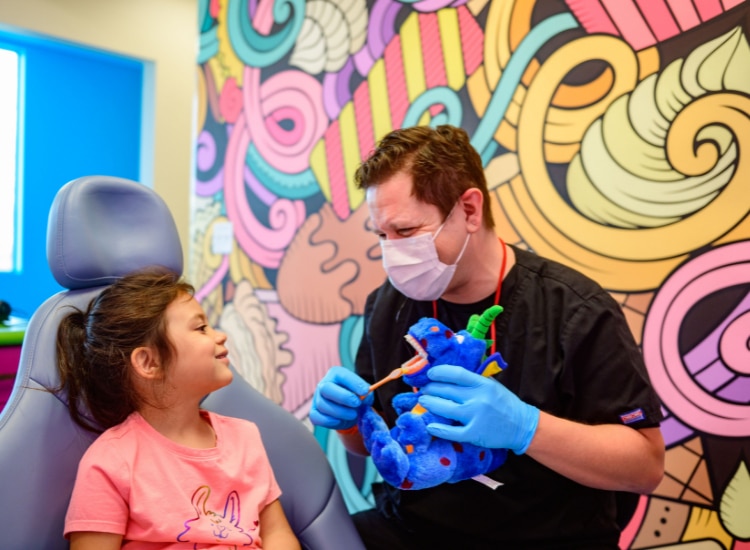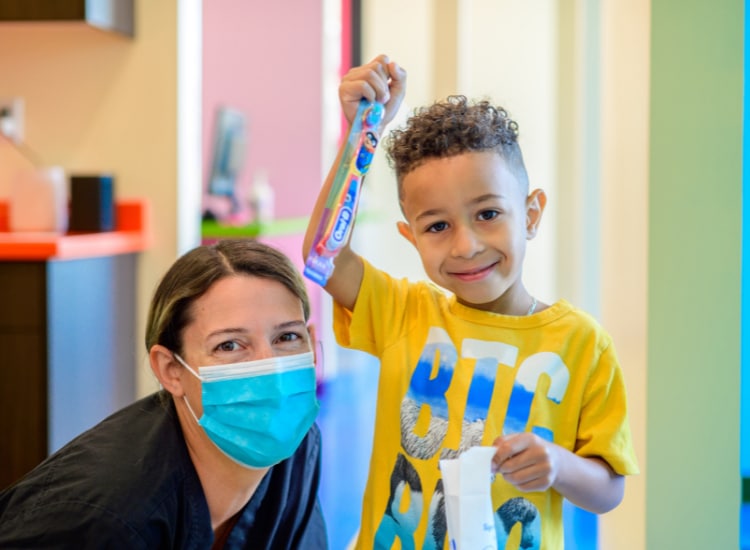How to Choose a Toothbrush For Your Child

Kids Dentist, Dr. Ari Hobfoll
Choosing a Child's Toothbrush

At Kaleidoscope Kids Dentistry, we love helping parents make the best decisions for their little ones. We pride ourselves on parents and patient education. In fact, one of our most frequently asked questions is how to choose a toothbrush for your child. With so many options on the market, it can be a challenge.
If you’ve ever been to your local grocery store’s dental area, you’ll understand what we’re talking about. There are brushes with varying lengths of bristles, brushes that massage your gums, and brushes that change color when used. In addition, there are brushes that play songs, brushes that light up, and more.
Options to Consider When Picking a Toothbrush
Toothbrush Size
When choosing a toothbrush for a child, ensure it fits comfortably in their hand. If the size and angle are uncomfortable, the youngster will be less inclined to use it long enough to clean all mouthparts. Our dentist for kids in Salt Lake City shares that small, age-appropriate toothbrushes work the best in little mouths to get into tight spaces. If you are doubtful, consult with your kids dentist.
Soft Bristles or Firm Bristles?
The hardness of the bristles is a critical consideration. Stiff bristles may be more effective for cleaning charred meat from a grill or hard water deposits from a shower floor- your teeth! Our friend Dr. Boals, shares that brushes with medium or hard bristles might cause gum injury.
The bristles of soft and extra-soft toothbrushes are firm enough to provide a deep clean and remove plaque, food particles, and surface stains from your teeth. Soft bristles are also more adaptable for reaching and can reach all the nooks and crevices. So, make sure to always look for a soft-bristled toothbrush.
Electric Toothbrush or Manual Brush?
Kids’ toothbrushes come in both electric and manual options. When deciding which one is best, it will largely depend on your child’s preferences. Research shows that an electric toothbrush with a small brush head does clean teeth better than a manual toothbrush. That being said, the BEST toothbrush for your kids is the one they want to brush with. Dr. Ari brushes with a manual toothbrush some days, and an electric one on other days, depending on how he feels. An electric toothbrush is not a replacement for good brushing technique and habits.
Toothbrushes for Different Age Groups

Toothbrushes for Babies
Oral-B Pro-Health Stages Toothbrush (Ages 0-2)
This brush has a rubber grip handle which allows for easy brushing for parents. The handle also allows for your child to eventually begin to use the brush themselves. It has ultra-soft bristles that are perfect for your baby’s tender gums.
Toothbrushes for Toddlers
This toothbrush is perfectly sized for toddlers and has an easy grip handle so your child can start to learn how to brush their teeth on their own. It features soft bristles that are gentle yet still effective at cleaning your toddler’s teeth.
Colgate Kids Battery Toothbrush
If your toddler prefers an electric toothbrush, the Colgate Kids Battery Toothbrush is a great way to get them starting to learn how to brush their teeth. These brushes are available in multiple different colors and feature popular cartoon characters. It also has a timer that will help to encourage your toddler to begin the habit of brushing for two minutes.
Toothbrushes for Kids
Oral-B Kids Electric Tooth Brush
The Oral-B Kids Electric Tooth Brush is a great option for kids. It has a small circular head like the cleaning tools you would see at the dentist. It is also available in lots of fun themes and colors.
Get Your Child Involved

We want your child to be excited about their oral health. Dr. Hobfoll, the best pediatric dentist in SLC, shares that letting your child pick out their toothbrush is a great idea. Having a toothbrush that plays their favorite song, is their favorite color, or is an excellent, funky shape, is an easy way to get your kiddo excited to brush.
“Our team at Kaleidoscope Kids Dentistry will do everything possible to avoid cavities with frequent cleanings and examinations. We are highly qualified to provide your children with high-quality, cutting-edge dental treatment while developing excellent dental habits that they can carry with them at home.” – Dr. Ari Hobfoll
What About Flossing?

Maintaining good oral hygiene in children is crucial for their overall health, and this includes both brushing and flossing. While it’s beneficial for kids to start practicing these habits early on, it’s important for parents or caregivers to actively assist with brushing and flossing until children develop the necessary dexterity. Typically, this level of manual dexterity is similar to the skill required to tie shoelaces quickly and efficiently, which usually occurs around the age of 7.
Until then, children might not have the fine motor skills needed to thoroughly clean between their teeth and along the gumline. By taking an active role in their dental care routine, you can ensure that their teeth and gums remain healthy, preventing cavities and gum disease. Encouraging your child to practice alongside you can also help them learn the correct techniques and build good habits for the future.
Plan A Dental Cleaning For Your Child

Are your child’s toothbrush and brushing methods effective? We can help you find out. Our exceptional dental hygienists at Kaleidoscope Kids Dentistry teach our patients of all ages to correct brushing practices.
Cavities can emerge when your child’s teeth are exposed to sugary or carbohydrate-containing meals. Sugars and carbs can build upon and around your child’s teeth after they eat, causing plaque to form on the enamel. As a result, your children may develop cavities. Fortunately, we specialize in Children’s Cavity Prevention. In addition, we will work hard to instill a passion for brushing and flossing in your child, resulting in better checkups and fewer cavities. Contact Kaleidoscope Kids Dentistry today to learn more!
















